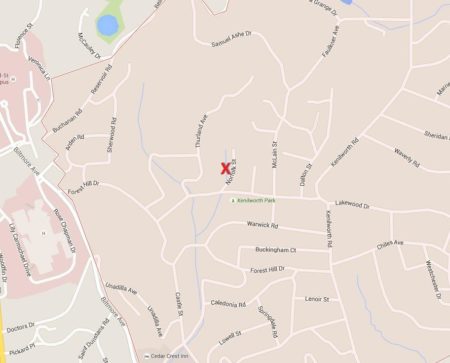 Location & History
Location & History
Located Southeast of Downtown Asheville, Kenilworth is nestled between Beaucatcher Mountain and the Swannanoa River, bounded roughly by Tunnel Rd to the East and Biltmore Ave to the West.
Founded in 1913 as the Town of Kenilworth by a group of developers, Kenilworth saw much of its growth in the 1920s. When it was time to lay out the streets, one of the developers, Jake Chiles, determined the streets should run where his horse chose the easiest path up the hills, stating, “Build the roads where the horse hoofs are,” explaining the unique winding nature of the streets today. Chiles also created Kenilworth Lake in 1925 with the damming of Ross Creek. In 1928, The Town of Kenilworth elected Leah Chiles as its mayor, making her the first female mayor in the state. The town was annexed by Asheville the following year after financial issues during the Great Depression. When Leah Chiles didn’t think Asheville offered fair value for the town fire truck, she challenged the city to a fire truck water duel in Pack Square and won.
Kenilworth is home to several landmark properties. One of the most enduring landmarks is the South Asheville Cemetery (1840s – 1943), the oldest public African-American cemetery in western North Carolina. Located behind St. John ‘A’ Baptist Church, South Asheville Cemetery is the burial site for over 2,000 free and enslaved African Americans. Today, the South Asheville Cemetery Association (SACA) coordinates volunteer activities related to the maintenance of the cemetery. In 2022, St. John ‘A’ Baptist was added to the National Register of Historic Places.
Kenilworth is also the home of the Newton Academy Cemetery. The cemetery was active from 1818-1919 and is the grave site of American Revolution soldiers and Civil War soldiers from the Union and the Confederacy.
Kenilworth’s most visually prominent landmark is the Kenilworth Inn (1902, rebuilt in 1918). Originally a resort hotel, then intermittently a US military hospital and a psychiatric hospital, the inn has been renovated into residential apartments. The Cedar Crest Inn, a Queen Anne architectural gem originally called the Breese House, was built in 1891. Zealandia, a castle-like structure, was built in the same period and housed Asheville’s first art museum.
Kenilworth Today
Exploring Kenilworth today, you’ll find an eclectic mix of 1920s Spanish-style villas, Tudor homes, and Craftsman bungalows, with ranch, modern, and multifamily styles added in the following decades. Kenilworth has five parks: Kenilworth Park and Leah Chiles Park – featuring playgrounds and ball courts – and Meadow, Seven Springs, and Forest Parks which provide walking trails and green space. Harvest House offers diverse programming from its Kenilworth Road home for all city residents hosted by Asheville Parks and Recreation. One of the great ways to explore Kenilworth is by attending the annual Kenilworth Artists Studio Tour – hosted by the Kenilworth Artists Association (KAA).
Kenilworth is also home to the Kenilworth Residents’ Association (KRA), a 501.c.3 neighborhood organization dedicated to building connections among residents – longtime and newcomers alike. Free to join, the KRA hosts events, community education nights, and workdays throughout the year, including the 4th of July Parade, Neighborhood Wide Yard Sale, Parent’s Night Out, Clean Up Days, and more.
In 2018, the KRA dedicated a previously unnamed creek running from Kenilworth Park through Meadow and Seven Springs parks “Gibson Creek,” after resident and community leader George Washington Gibson Sr. for his commitment to restoring South Asheville Cemetery. In 2022, the KRA Historical Committee created an interpretive sign highlighting George Gibson Sr.’s work and the history of the South Asheville community, settled in the 1800s by free and enslaved people of color and later annexed into Asheville and a part of Kenilworth. These efforts led to the creation of George Washington Sr. Day and South Asheville History Day on March 4 by the City of Asheville and Buncombe County.
